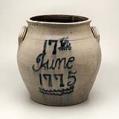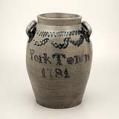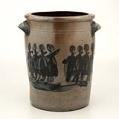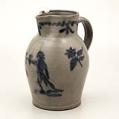Collection: Mariner Southern Ceramics Gallery: War

Pitcher
Attributed to Henry Remmy
Baltimore, Maryland
1814
Salt-glazed stoneware
The William C. and Susan S. Mariner Collection (5813.67)
The commemoration of war and heroic deeds has been part of the potter’s repertoire since Greek vase makers recorded the Sacking of Troy. In our relatively short history, the American Revolution, the War of 1812, and the American Civil War have left both lasting monuments and deeps scars. The stoneware examples exhibited in this case are extraordinary remembrances of those conflicts.
The large stoneware jar with an applied molded eagle is inscribed “Genl Andrew Jackson”; the reverse is emblazoned with “17th June 1775,” the date of the Battle of Bunker Hill. Attributed to Barnabas Edmands of Charlestown, Massachusetts, the jar was made in honor of President Andrew Jackson’s visit to the site of the Bunker Hill battlefield on June 26, 1833. Although made in the North, this pot is a tribute to Jackson—a famous Southern politician and military hero.
Whereas Bunker Hill marked the beginning of the American Revolution, the decisive concluding victory took place in Yorktown, Virginia, on October 19, 1781. At first glance one might assume that the jar inscribed “York Town / 1781” was made at that time. However, it was made in 1824 by Baltimore potter William Morgan in tribute to the Marquis de Lafayette’s visit to that city during his year-long American tour. With the battle of Bunker Hill and Yorktown serving as bookends to the Revolutionary War, these two jars in tandem are among the most historically important stonewares in America.
The small, incised pitcher attributed to Baltimore potter Henry Remmey shows an American militia officer shooting a duck or goose from the sky with a flintlock pistol. Despite the somewhat comical scene, it references the Battle of North Point, a pivotal event during the British attack on Baltimore on September 12, 1814. In that engagement American General John Stricker commanded the Baltimore defense forces against the British. When British Major General Robert Ross was shot by an American sniper—from a considerable distance—Colonel Arthur Brooke took over for the British. Brooke later reported that he had heard a boastful comment from an American that “our riflemen can shoot a duck through the head with a Single Ball at two hundred yards.”
The Thompson pottery of Morgantown, Virginia (West Virginia after 1863) is known for its “people pots”—stoneware made and decorated by potter John Thompson and his family. A nephew of Thompson, John Greenland of Connellsville, Pennsylvania, made the 3-gallon jar depicting a Civil War rifle unit accompanied with a marching band, a common sight in many towns at the time. Twelve individual figures are represented each painted with broad cobalt-blue brushstrokes. The scene on this stoneware jar is a poignant visual reminder of a terrible period in our country’s history.




